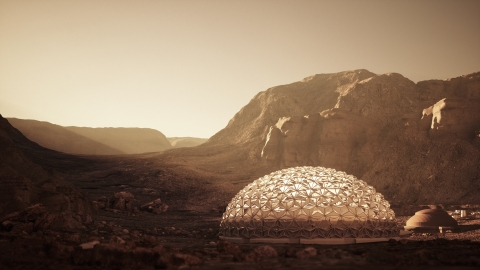

The design of a city on Mars - which can house one million people in a sustainable way - has reached the final.
What would a city look like on the planet Mars? An international team has reached the final of a competition for its design of a city, which would allow for ‘Life on Mars’.
The Mars city proposal was authored by researchers and professionals from all over the world, including a PhD student from the University of Portsmouth who is passionate about finding ways for humankind to exist on the red planet.
Miquel Banchs-Piqué, from the University’s School of Civil Engineering and Surveying, is a member of The Sustainable Offworld Network (SONet) – a community of professionals in the academic and private sectors dedicated to the development of sustainable human settlements, especially on the Moon and Mars.
I am convinced that the effort to design self-sustainable off-world settlements will help in finding strategies to improve our sustainability on Earth.
Miquel and his SONet colleagues beat nearly 200 other teams to be in the top 10 who will present their proposal in the final of the Mars Society's competition for the best design of a Mars city state which can house one million people in a sustainable way.
Miquel said: “I joined SONet because I am convinced that the effort to design self-sustainable off-world settlements will help in finding strategies to improve our sustainability on Earth. Pursuing extra-terrestrial habitation may also make humanity resilient to global catastrophic events that could hit the Earth.”
The team had to consider what a city would look like, how trade would work and how the urban population would evolve. They also had to submit detailed descriptions of their plans for the industry, infrastructure, and the generation and distribution of energy and services.
Miquel said: “We named our city NÜWA in honour of the Chinese goddess who created humanity, which symbolises the beginning of a new era of our civilisation on Mars and the protection that must be ensured in such an inhospitable world.”
Guillem Anglada-Escudé, researcher from the Institute of Space Sciences and co-ordinator of the team, said: "The proposal is an effort to combine many disciplines in a way that is not usually done in space projects. In addition to scientists and engineers, we wanted from the very beginning to incorporate experts in other disciplines and from outside the academic sector."
The SONet team is made up of 29 specialists including engineers, architects, astrophysicists, biologists and chemists from Spain, Germany, Argentina, USA and the UK.
The 10 finalists will present their designs this Saturday, 17 October, via Facebook live. To register, please sign up to the International Mars Society Convention by clicking here.
The team can be followed on Twitter @SONet_hub
